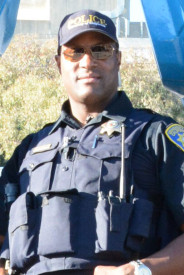‘Bears That Care’ aims to take a bite out of crime
Launched last fall, Bears That Care is an "active bystander initiative" that gives students tools for de-escalating, intervening in or reporting any potentially violent situations they encounter.

December 13, 2013
Violent crime is a harsh reality in every U.S. city, and Berkeley is no exception. At UC Berkeley, though, there’s encouraging news on the crime front: A growing number of students are getting violence-prevention training through the campus’s Bears That Care program.
Launched last fall, Bears That Care is an “active bystander initiative” that gives students tools for de-escalating, intervening in or reporting any potentially violent situations they encounter. By the end of the 2013 spring semester, 1,547 students had attended Bears That Care presentations. The program’s second academic year got off to an even faster start this fall, with more than 1,600 students taking part in trainings in October and November.
Bears That Care is less a reaction to any specific incident, campus officials explain, than a proactive way of addressing some of the unfortunate realities of city and campus life.
“Being in the Dean of Students Office and receiving information regarding students who were in crisis or had experienced violence or something traumatic, we felt it was important to acknowledge the current environment and make strides toward the type of community we envisioned for our campus,” says Assistant Dean of Students Akirah Bradley.

UCPD Detective Quincy Ruffin and other volunteer trainers have been helping students learn new violence-prevention techniques.
“The police cannot always be there to help people,” adds Quincy Ruffin, a detective in the UC Police Department’s threat-management unit. “There are roughly 66 officers in our department, and they are not all working at the same time. Even if they were, they could not cover every spot on campus. The solution is to have the community provide support for itself. This way, people are taking responsibility for their own environment and supporting each other. That’s what a community is.”
Led by volunteer staff members, the hourlong presentations are held in campus classrooms and residence halls and focus on a violence-prevention approach called the CARE model. Developed by Bradley with support from an advisory board of staff members from the Division of Student Affairs, the model has four steps: Confront the situation, Alert others, Redirect attention, Engage peers. By the end of the training, students have learned how to spot trouble, establish personal boundaries, avoid obstacles to taking action and step in safely to help others.
“I think people don’t get involved with things they see in their community because of fear,” says Ruffin, who regularly serves as a Bears That Care presenter. “This gives them choices and a way to get involved without placing themselves in danger. They can go with their own comfort level.”
Ruffin emphasizes that “getting involved” doesn’t mean getting physical – a point that opened some eyes when he led a Bears That Care training for the Cal football team. Ruffin shared a story about an experience of his own, when he tried to break up a fight while in plain clothes and ended up having the guns of responding police officers pointed at him. After that, he took a different approach in such situations.
“I explained to them that even as a trained police officer, I get involved with situations from a safe distance,” Ruffin says. “They all expected me to be the one to get physically involved with every situation because of my position and training. After that story, several of them had stories of their own to offer. It was a different way of thinking of being an active bystander.”
Bears That Care trainer Roxanne Llamas-Villaluz has an intense personal connection to violence prevention as well: She was the victim of physical, emotional and verbal abuse throughout her childhood, and is also a survivor of sexual assault.
“The people that could have intervened on my behalf, including myself, did not have the education, understanding or community support around what it means to be an active bystander as well as the many options available to intervene,” says Llamas-Villaluz, an academic program coordinator in the Office of Student Development. “So being a part of a program that seeks to educate is why I continue to remain involved.”
Llamas-Villaluz has seen that education pay off. At one Bears That Care presentation, for instance, a student talked about seeing friends who were about to engage in sexual activity with intoxicated partners.
“They realized that those people were not able to give consent, and that they actually could have said something or done something,” Llamas-Villaluz says. “Before the presentation, they thought it was normal to engage in that type of behavior. They also acknowledged they had been in situations where they felt someone could be harmed but didn’t know how to intervene.”
Every student who takes the Bears That Care training fills out an evaluation survey, and the results have been encouraging. Eighty-three percent of student attendees indicated that the presentation increased the likelihood that they’d take action to head off violence. And the evaluations are also leading to some adjustments to the program, according to Bradley.
“We received feedback from a few students stating that having staff present feels like their parents telling them what to do,” she says. “The feedback was helpful, and we are in the process of creating student paid positions for a peer-to-peer model for this program.”
Dates for 2014 trainings will be announced soon. For more information, visit the Division of Student Affairs website.